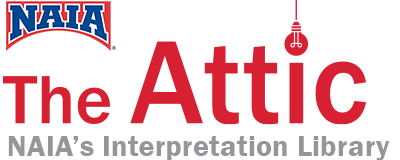-
Implications to Accepting Money as an Amateur Athlete
Article VII, Section C: Recognized Awards Received By Students The NAIA shall recognize the following award structure for awards directly resulting from place of finish or participation in athletics as conforming to the amateur regulations of this Association. 1. Individual awards presented to a student in recognition of intercollegiate athletics participation, or other athletic participation…
-
Institutions Offering 2-Year & 4-Year Degrees
Article V, Section B, Item 22: Definition of a Transfer To determine if an institution that offers both associate and baccalaureate degrees should be categorized as a two-year or a four-year institution: a. If the institution participates in an intercollegiate athletics association that distinguishes between two-year and four-year institutions, the division the institution has…
-
Repeat Courses
Article V, Section C, Item 12 A repeat course is defined as a course term, summer or nonpreviously passed with a grade of “D” or better in any term, and subsequently retaken. For the purposes of this rule, the NAIA does not recognize a +/- attached to a letter grade. Consequently, a B+ or B-…
-
Mid-Year Certification
Article V, Section C, Item 14 A student who is eligible the last day of a term (as reported on the institution’s official academic calendar) may retain eligibility until midnight of the 30th calendar day following the close of a term to allow an institution time to recertify eligibility through the official Eligibility Certification Process.…
-
Mid-Year Eligibility for Freshmen
Article V, Section C, Item 5: Mid-Year Eligibility & 9-Hour Rule Definition of an Entering Freshman, V.B.5 : A student who upon becoming identified with an NAIA institution has not been previously identified with any institution(s) of higher learning for any two semesters or three quarters (or the equivalent). V.C.5.a (Nine-Hour Rule) An entering freshman who…
-
Use of Non-Term Credits – Reliance on Transcript
For the 2021 Convention, the membership passed a bylaw on how to apply inter-term credit earned for eligibility purposes. While this bylaw application is listed under Article V, Section B, Item 10: Definition for Inter-Term, the guidance on how to evaluate inter-term credits covers all non-term credits such as summer courses or online, non-traditional courses.…
-
Tryouts with Prospective Students & 24-Week Season
Approved Ruling: Tryouts of prospective students, in accordance with NAIA Bylaws, shall not constitute practice per Article I, Section H, Item 6, although institutional team members may be involved. Such activity if conducted outside of the team’s 24-week season will not trigger the 24-week season. The National Eligibility Committee has ruled that the “prospective student”…
-
24/36-Hour Rule Exception Junior College Transfers
Article V, Section C, Item 6, Exception 2 states: EXCEPTION 2: A transfer student who has met the graduation requirements for an associate degree from a junior college in the previous two semester or three quarter terms of attendance will be exempt from meeting the 24/36-Hour Rule for the first two terms of attendance upon…
-
Participation Prior to Enrollment in the Fall
Approved Ruling: When an institution has scheduled an intercollegiate contest prior to the opening of school in the fall, a student shall be allowed to represent the institution although the student is not officially identified at the time of participation. The NAIA Official Eligibility Certificate must be filed with the eligibility chair with the column…
-
Prospective Student-Athletes: Tryouts, Camps/Clinics, & Practice During Academic Term
Tryouts Approved Ruling: Tryouts of prospective students, in accordance with NAIA Bylaws, shall not constitute practice per Article I, Section H, Item 6, although institutional team members may be involved. Such activity if conducted outside of the team’s 24-week season will not trigger the 24-week season. Tryouts may occur at any point throughout the calendar…
